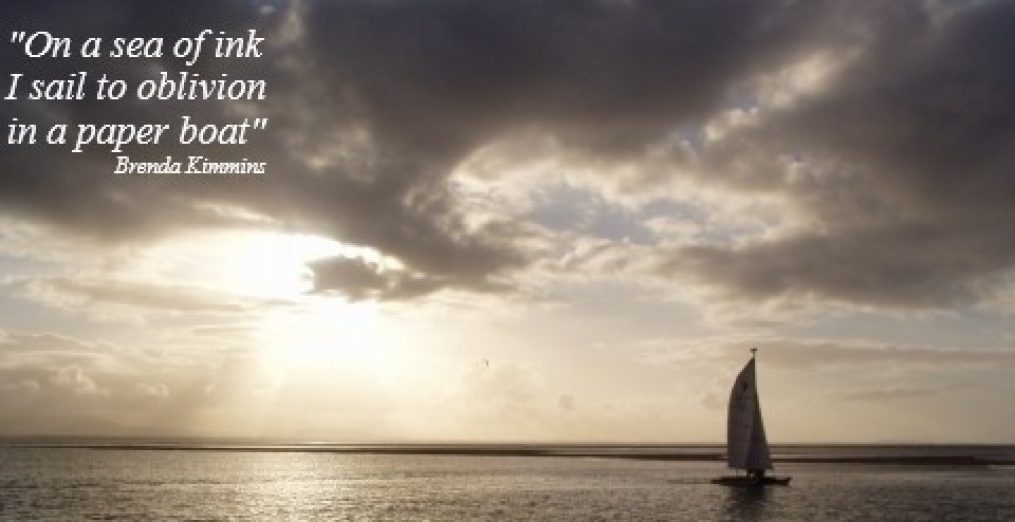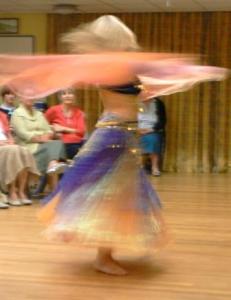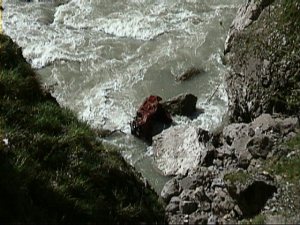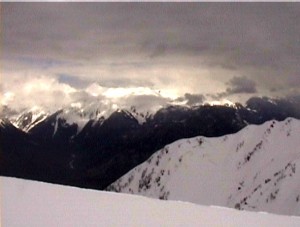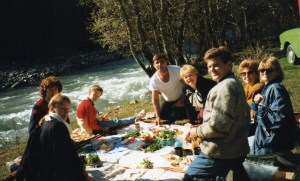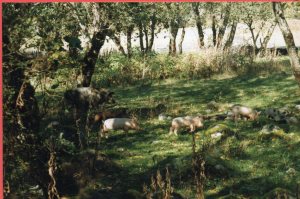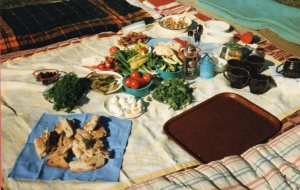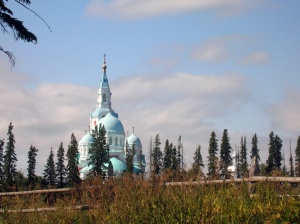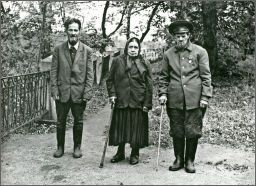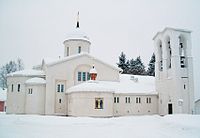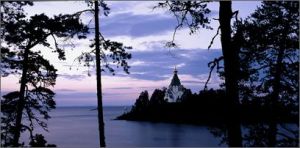
When I wrote my Haiku, entitled ‘Sleep’, about a 36 hour trip on a sleeper train from Moscow to Sochi, I said that I would write more about my Russian adventures. This is the first instalment!
It was October 1995 when my colleague, Liz and I got up very early at the Hotel Moscow in Sochi. We were being taken on a trip to the Caucasian Mountains for the day. We skipped breakfast and went out to meet Igor, his young daughter Anna, the 2 Natalya’s, both Headteachers, Irena, our interpreter, and another couple. We were driven out of Sochi along the airport road in two Ladas. We followed the Black Sea coastline until we reached the ‘new’ airport which was being built by construction workers from Yugoslavia, as it was then. Apparently they never have enough money for materials so the job is taking years to complete. However, what they have built looked very modern, even futuristic, and very impressive.
At this point we turned inland towards the mountains. We could not go straight on as this was the road to Georgia and there were still Russian tanks along the border to stop refugees from the Abkhazia/Georgia conflict from coming into Russia.
From here on, the journey took two or three hours, passing some of the most spectacular scenery I have ever seen. It reminded me of the best of the Pyrenees with shades of Canada. The colours of the ancient forests of broadleaf trees were indescribably beautiful: Reds, yellows, oranges and all shades of green glinted in the glorious early morning sunshine. Above these trees were the alpine forests of evergreen trees, and beyond those, the everlasting snows. This is the home of the Russian bear, the mountain cat, the black Ousel, the wolf and much more.
All the time we were driving along the course of the ‘wild river’, as its name translates. This river is icy cold, deep and treacherous, coming straight from the snow-capped mountains. I was told that there are 1 metre long red fish (presumably salmon) in this river. The road got steeper, and narrower, and more winding as it climbed higher into the mountains. There were many interesting stops; the Men’s Tears Waterfall, the Ladies’ Tears Waterfall, the ancient cave where Neolithic tools have been found, the memorial to the Red Army soldiers from Krasnapolyana who were butchered and thrown into the ravine in 1927 during the civil war, to name just a few. The road was so dangerous that we could not get out and take many photographs unfortunately.
Eventually we arrived at the village of Krasnapolyana where Igor was born. It was like going back to medieval times in England. There were very few cars, and ours had to drive dead slow to avoid the pigs, hens, cows and dogs wandering at will through the main (and only) street of the village. There were very few people around but one or two slowly plodded by. The pace of life in this village is so slow that it seems as if at some point time stopped, stood still, and then started to go slowly backwards. All around there were little Hansel and Gretel cottages with tiny barns packed to the rafters with the harvest produce. Not a shop or a pub to be seen ~ just little old people living on whatever they could grow or rear, in little houses with little gardens.
We were told that the air and water is so pure here that people have been known to live to 130 or even 140 years old. Some years ago the world’s top biologists got together to stop a bid to hold the winter Olympics in the area. They considered Krasnapolyana to have the purest and cleanest environment in the whole world. I can believe it and I am so thrilled that I got to see it in this unspoilt state. It looked and smelled like Paradise to me.
At last we drove the last few bumpy metres through the forest to a clearing by the river. Here we stooped and got out of the cars. The sun was very hot by now and the air was soft, warm, and full of sweet perfume. It was explained to me that much of the greenery growing in the forest could be used for herbal remedies. Every bit of ‘grass’ I picked seemed to have an exotic smell and curative properties according to Natalya. As Liz and I wandered round in raptures at the scenery, the women in our group set about laying out a picnic area.
They emptied the two Ladas and laid out blankets, mattresses, sheets of cardboard, dishes, bowls, cups and saucepans. Then, out came flasks of tea and coffee, bottles of Russian Vodka and an amazing array of green salad, huge tomatoes, freshly made Georgian Lava bread and homemade cheese. Meanwhile the men returned from the forest with twigs, sticks and small branches. They set about building a fire with great precision. Apparently building a fire for cooking food is an exact science, and Russian men take great pride in it. Once the fire was lit, it was fussed over like a new baby until it was ready to put the meat over. Igor skewered three whole chickens which had travelled with us in a huge pan marinating in a batter flavoured with herbs and spices. The men collected water from the river and splashed the fire and the chickens regularly. They told me that this helps stop the chicken’s skin from burning and keeps it moist as it cooks right through. The smell coming from this outdoor barbecue was mouth-watering and I couldn’t wait to eat the food. Liz, being vegetarian, had been horrified by the whole process, but was glad to see a vegetarian selection cooking on a skewer at the edge of the fire.
As the men cooked, animals wandered by to take a look: a family of wild pigs complete with babies, cows of all sizes and shades, dogs and butterflies. It really was quite primitive and biblical and I was totally relaxed just watching and anticipating. When we did sit down on the ground to eat, the meal was superb. Every sense was alive with the sight, the feel, the smell and the taste of the food was complemented by the sounds of the fire spitting and the river rushing by. It was an amazing experience. At the end of the meal we wandered round with 10 year old Anna, writing our names on stones with stones, and drawing the animals we could see, rather as Neolithic man must have done in those caves we had seen. Finishing up, we cleared everything away and set off again to go further along the mountain track.
Liz and I were told that we were going to touch the everlasting snows. I had a dreadful feeling that we were going up the mountain on horseback. But then to our amazement we saw an old ski lift! Before we had time to panic we were sitting on this thing which climbed as far as the eye could see up into the snow-capped mountains.
I was not in the slightest bit bothered by it. I thought this totally untypical relaxed state might have been due to the environment, but Liz reckoned it was due to all the vodkas I had consumed at lunchtime! Either way I loved the splendid views from the top of the ski lift.
After this we set off on the homeward journey. We took detours to give messages to grandmothers, to buy curative honey from the bee farm, to drink coffee, and to see the hydro-electric station and reservoir that supplies these remote and fortunate people with their power. They seem to have everything they need in abundance and all naturally produced. It was a most unusual, thought provoking, pleasurable, and satisfying day. I was very sad to leave Krasnapolyana.
The views on the way down the mountain were even more spectacular than on the way up. The setting sun gave the already beautifully coloured autumn leaves a shimmering golden glow. The only hiccup occurred when I dropped my jar of medicinal honey from this wonderful place. The beekeeper had gone to so much trouble to find me a small jar and filled it for me to take home. But, it smashed to bits right outside our hotel. It seemed almost as if I was not supposed to take anything away from Krasnapolyana.
I have been back to Krasnapolyana several times since then and it has changed out of all recognition. There are new roads, helicopter pads, tourist hotels, new ski lifts and lots of palatial new houses. Mr Putin has a beautiful summer home there and skis regularly on the mountain. And, I am sad to say that the 2014 Winter Olympics will be held in Krasnapolyana, which will bring masses of people and vehicles to this fragile but still beautiful area. I fear that the environment will be ruined. But I feel privileged to have seen it when it was still in pristine condition.

Igor, Natalya, Liz and friends picnic Russian style

Igor in charge of the campfire

Wonderful fresh food cooked over the fire beside the river

Unspoilt forest and wild pigs at the foot of Krasnapolyana

melted snow feeds the river rushing down towards Sochi

Krasnapolyana in 1995
